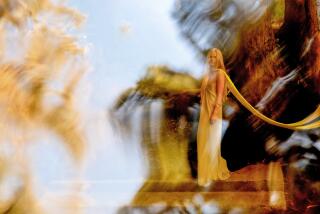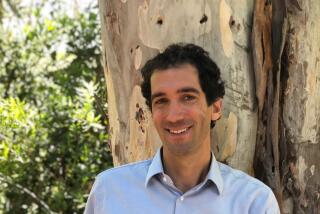How rich the English canon
- Share via
“Albion” could be called a history of the English imagination as it has manifested itself in literature, music and art. But it is less a formal history than an evocative and entrancing magical mystery tour that takes us from the misty Anglo-Saxon world of Caedmon, “Beowulf” and “The Seafarer” to the modern world of Ralph Vaughan Williams, T.S. Eliot and W.H. Auden.
Meditative, erudite and intuitive, “Albion” is history aspiring to the condition of poetry:
“Of the English imagination there is no certain description. It has been compared with a stream or a river .... It can be compared to an aeolian harp, of which ‘... the long sequacious notes / Over delicious surges sink and rise....’ These words of Coleridge suggest in turn the drawn-out melodies and vast chromatic harmonies of the English musical tradition.” Ackroyd finds a still more powerful image in the words of 17th century poet Henry Vaughan: “Like a great Ring of pure and endless light.”
Ackroyd’s meditation on this vast and ineffable theme includes not only English literature but also English music, art, architecture and even horticulture. Poet, novelist, biographer and critic, Ackroyd is a man consumed by a “passion for the past,” to borrow a phrase from the elegiac Alfred, Lord Tennyson, who even as a child had been entranced by the “long ago and far away.” This passion pervades Ackroyd’s work, from his biographies of William Blake, Charles Dickens and Sir Thomas More to his novelistic portraits of Oscar Wilde, Thomas Chatterton and architect Nicholas Hawksmoor.
This passion for the past, Ackroyd maintains, has always been a quintessentially English passion. We see it today in historical novelists such as Barry Unsworth, Rose Tremain and Ackroyd himself. It is equally evident in the medievalist revivalism of such Victorians as Dante Gabriel Rossetti and William Morris, and in the Gothic vogue of the Romantic age. And, as Ackroyd points out, even in those ancient times that evoke such nostalgia in later eras, bards and chroniclers such as the Venerable Bede (c. 673-735) were waxing elegiac over the runes and ruins of a still more distant past.
But what does it mean to talk about the English (or any other) national character, tradition or sensibility? Is it a form of nationalist or racist thinking? As Mario Vargas Llosa has remarked, “Any concerns about the ‘identity’ of a human group make my hair stand on end, because I’ve become convinced that behind them always lurks a conspiracy against individual freedom.” And sometimes behind them lurks a conspiracy to glorify the native-born and exclude the outsider.
Such, however, is not the case with Ackroyd’s celebration of the English imagination. Indeed, as he demonstrates, one doesn’t have to be English to partake of English tradition: The German painter Hans Holbein, the Swiss painter Henry Fuseli and the American poet T.S. Eliot are but a few of many artists who indubitably became part of English tradition.
Ackroyd quotes one commentator who noted that the German-born Handel’s oratorio “The Messiah” “sums up to perfection and with the greatest eloquence the religious faith, ethical, congregational, and utterly unmystical, of the average Englishman.” “Handel himself,” Ackroyd goes on, “became a naturalised Englishman in 1727, after his art had been thoroughly assimilated. The power of place,” he notes, “is once again manifested. We may call it placism, as an antidote to racism.” And perhaps the ineffable essence that Ackroyd describes has, ultimately, less to do with a sense of place than a state of mind.
Yet Ackroyd leaves us in no doubt that place is a crucial shaping factor. The English imagination, he insists, has something to do with what it is like to live on an island surrounded by cold seas, inundated with rain, blessed with trees once worshiped by the Druids: “That is why Hippolyte Taine, the French critic ... hears the first music of England in the fine patter of rain on the oak leaves. The poetry of England is striated with the shade that the ancient trees cast, in a canopy of protection and seclusion.” Ackroyd points to the green-clad Robin Hood of Sherwood Forest, the sylvan landscapes of Thomas Gainsborough and John Constable, Tennyson’s “immemorial elms,” the role of trees in the novels of Charlotte Bronte, George Eliot, Thomas Hardy and D.H. Lawrence. And then there were those “fifteenth-century English mystics [who] saw trees as men walking, a vision recalled by Tolkien in his legend of moving trees or Ents in ‘The Lord of the Rings.’ ”
The English language itself is a testament to the principle of inclusiveness. Although some writers have made a cult of preferring the sturdy, simple English words of “pure” Saxon origin to those of Latin, Greek or Norman French origin, the true glory of the English language, Ackroyd feels, comes from its richness and its ability to assimilate foreign words. Similarly, the English style is a mixed style -- or, to use an ancient term, as Ackroyd generally prefers to do, a “mungrell” style: “ ‘Beowulf’ combines heroic adventure and horror, pathos and fantasy.... Spenser delights in his alterations of mood. Marlowe specializes in comedy and horror mixed.... Precisely the same descriptions have been applied to both Shakespeare and to Dickens.... “ Shakespeare’s plays pay no heed to the classic “unities” of time, place and action. And in them are mingled poetry and prose: The most exalted poetic language can be found cheek by jowl with puns to amuse the groundlings.
Everywhere he looks, Ackroyd finds continuities persisting down the centuries, whether it’s a reverence for trees, a tendency toward melancholy, a preference for understatement or a fondness for intricately curved and spiral forms rather than straight lines in English art, architecture and gardens. In one chapter, Ackroyd discusses how the men who labored to produce the King James Version of the Bible incorporated the language of versions by earlier translators, such as William Tyndale. And, in turn, the language of the King James Version, deliberately archaic, breathes through the poetry and prose of Milton, Bunyan, Wordsworth, Lawrence and Eliot. Ackroyd loves continuity: “It is always wise to look for evidence of continuity rather than of violent change, because in persistence and permanence lie the true strengths of human nature.” This conservative tendency, this unwillingness to throw out babies along with bathwater, also is a force that nourishes diversity -- through the realm of time rather than space. Voices from the past are not silenced by death or change but resonate in a music that transcends time.
The English imagination, like any living creature, is full of paradoxes. Many a trait that Ackroyd identifies as typically English is matched by an opposite trait, equally English. The English, he notes, are known for their bawdy humor yet are embarrassed about sex and, indeed, the physical body in general. On one hand, they are pragmatic and down-to-earth. In religion they value practical matters rather than theological speculation. In philosophy their approach is empirical: They value inductive reasoning and the kind of purposeful experimentation that led to modern science, while distrusting and disdaining speculation, systems and abstract theories and concepts. The English are skeptical.
Yet on the other hand, as he also shows us, England is a land of visions and dreams, of ghosts and revenants: Most ghost stories are set in England and written by English writers. And from time immemorial the misty island has been full of visionaries: from William Langland’s “Piers Plowman” to Blake and Samuel Palmer.
Oddly, Ackroyd’s chapter on Romanticism is rather weak. And he suffers from a slight tendency to overly idealize the “good old days” of England’s Roman Catholic past -- today’s answer to the 19th century’s Protestant triumphalism. His attitude is very much in tune with current fashions in British historiography, although, to his credit, he is clearly appreciative of the Dissenting tradition, with its emphasis on individual “inner light.” Yet he seems to overlook the fact that what he idealizes as the halcyon Catholic past already contained the seeds of dissent: that Protestantism was not just the politically motivated improvisation of Henry VIII. This blind spot enables Ackroyd to perform the neat trick of honoring Tyndale for translating the Bible while exalting More, who had him killed for that very “crime.”
Yet “Albion” is a mansion of many rooms, richly furnished and full of surprising treasures. Ackroyd’s extraordinary affinity for his grand subject has enabled him to produce a splendid book.
More to Read
Sign up for our Book Club newsletter
Get the latest news, events and more from the Los Angeles Times Book Club, and help us get L.A. reading and talking.
You may occasionally receive promotional content from the Los Angeles Times.










